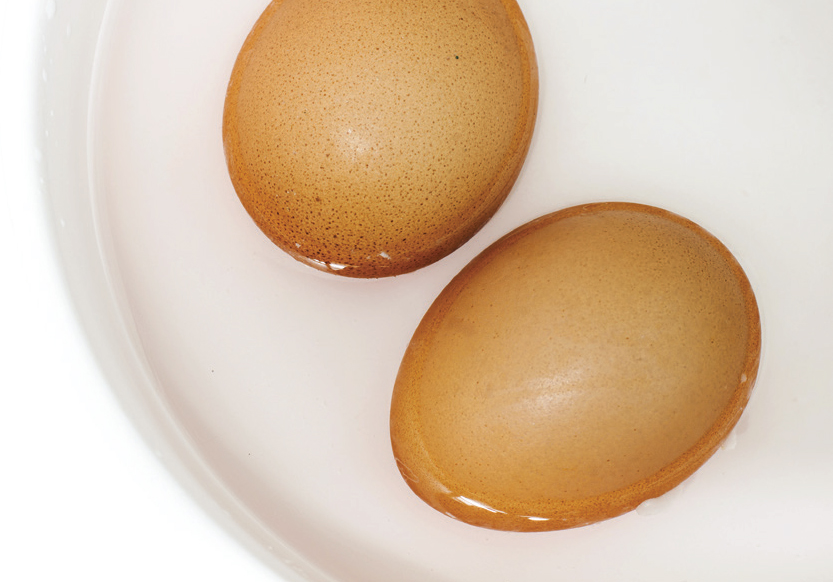People started domesticating wild chickens over 5,000 years ago. Over this time we have selectively bred into the chicken characteristics to make them not only better layers but also to produce a wide range of sizes, colours and feather types, from the common Isa Brown to the exotic and adorable Silkie Bantam. If all 200 breeds of the modern domestic chicken (Gallus domesticus) could be assembled in one place it would make for a very interesting and colourful family photo!
Generations of selective breeding have made chickens one of the most widespread, useful and beloved domestic animals in the world – it’s hard to imagine life without them. Thankfully, our understanding of how to care for them has evolved in step, and it’s easy to look after them just as well as they’ve looked after us.

ALL OF THE HUNDREDS OF BREEDS OF
DOMESTIC CHICKENS FOUND TODAY
HAVE A COMMON ANCESTOR IN THE
RED JUNGLE FOWL (GALLUS GALLUS)
OF INDIA AND SOUTH EAST ASIA,
WHICH IS STILL FOUND IN THE WILD.
DID YOU KNOW?
DNA analysis has shown that chickens are the closest living relative of dinosaurs such as T-Rex.
ANATOMY OF THE DOMESTIC CHICKEN
While it’s not necessary to be an ornithologist, a basic knowledge of chicken anatomy can be very helpful when talking about your home flock to other poultry enthusiasts or the vet.
Male and female chickens have all the same basic parts, and it can be quite difficult to tell them apart when they are young.
The differences between males and females become clearer as birds mature, with male chickens displaying a larger comb and wattles, and longer spurs than females.
The following diagram shows the key external features of the domestic hen.
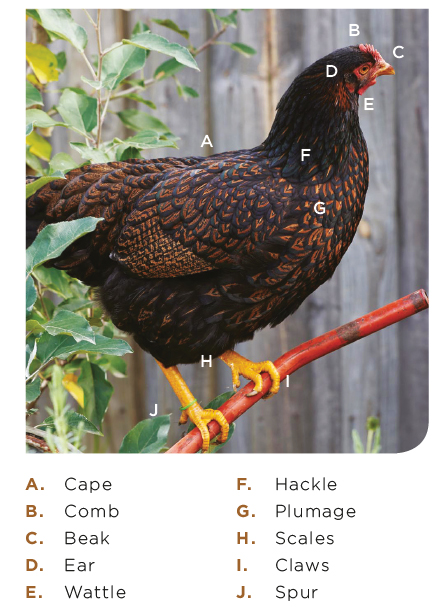
The following diagram illustrates the key internal features of the domestic hen.

CHICKEN CHARACTERISTICS AND BEHAVIOURS
Understanding chicken behaviour and characteristics will make it easier to take care of your home flock. Knowing how to recognise unusual behaviour can also help you pick up any issues with health or living conditions before they become serious.
Diet
Chickens are not vegetarians, as is often assumed. They are in fact omnivores, and in the wild are very happy to eat lizards, small snakes or young mice as well as seeds and insects.
Social behaviour
Have you ever wondered where the term ‘pecking order’ came from? Chickens!
They are social animals, but within a well-defined hierarchy that is quickly established when new birds are housed together. You’ll notice this most at feeding time, where the top hens will eat first, chasing off the lower-ranked and younger birds. Only when the
top hens have eaten their fill will the lower-ranked birds be allowed to eat.
They’re also very loyal, and can and do develop long-lasting bonds with each other. Sets of BFFs (best friends forever) can be found in backyard flocks.
Intelligence
Chickens are quite smart and have great memories. They can distinguish between over 100 different faces of people or animals.

DID YOU KNOW?
The gizzard performs a similar
role in chickens to what teeth
do in other animals. It uses a
muscular action to break down
grains and seeds with the help
of small stones and grit that
chickens swallow for this purpose.
DID YOU KNOW?
Chickens have exceptional eyesight
and they see the world in
colour, just like we do.
THE EGG
IT TAKES ABOUT 24 HOURS FOR A HEN TO MAKE AND LAY AN EGG
Fresh eggs are one of the main reasons that people keep chickens, so it can be useful to understand what they’re made of, how they form in the chicken and exactly what makes a good egg.
In the chicken’s natural life cycle, the egg is an incubation chamber for a developing chick. The egg contains everything the new chick needs during the three-week incubation period and the first couple of days after it has hatched – which is why eggs are so packed full of nutrients.
First the yolk (or ‘oocyte’) is produced in the ovary and then released into the oviduct. This is the point at which fertilisation will happen, with any luck, if the hen has mated with a rooster. If not, the egg will remain unfertilised.
As the egg continues down the oviduct the albumen (egg white) is laid down, followed by the egg shell. The egg shell is initially flexible (much to the relief of your chickens), but it quickly hardens once the egg has been laid.
EGG SHAPE
The familiar pinched oval shape of the egg is no accident. It offers a lot of important advantages to the chicken and any potential chicks growing inside.
First, the arched ‘dome’ is one of the strongest architectural forms, because it distributes weight and pressure equally across the entire structure. Try squeezing an egg from the ends and you’ll see what we mean.
The pointed oval is also the easiest shape for the hen to lay, which is no small thing when she’s laying up to 300 of them a year!
EGG SHELL STRENGTH
A GOOD EGG NEEDS A GOOD SHELL, NOT JUST TO HOLD IT TOGETHER, BUT ALSO TO PROTECT IT FROM BACTERIA AND CONTAMINANTS.
The egg shell is made primarily from calcium carbonate, known as “nature’s ceramic”, which is the same hard substance found in chalk, limestone and coral. Hens need a lot of calcium to produce strong egg shells.
Each hen requires around 4 grams of calcium a day, in order to get the 2 grams needed for one egg shell. In human terms, this is the equivalent of about 1.5kg of calcium per day (for a 70kg person), which is as much as you’d find in 1,500 litres of milk! This is one of the many reasons that a proper diet is so important for laying hens.
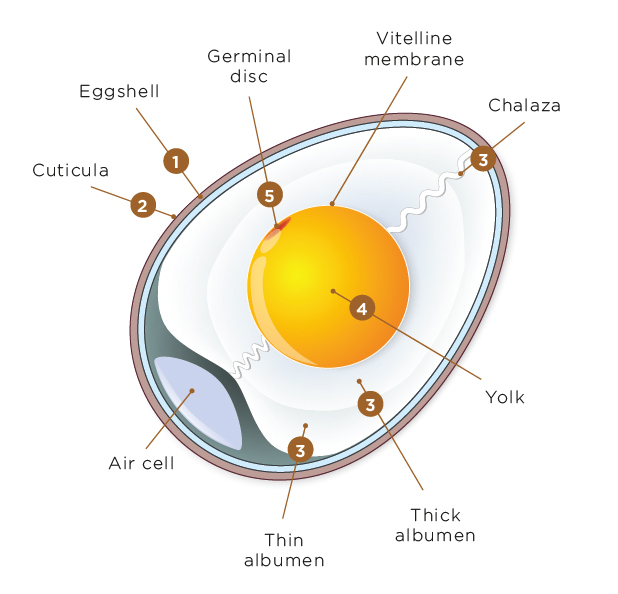
The egg is made up of 5 main sections
- The eggshell, which consists mainly of calcium carbonate, is quite porous, containing nearly 8,000 minute holes through which gases and water vapour can pass.
- The shell membrane (cuticula), which acts as a barrier against bacteria.
- The layered albumen (egg white) including the chalaza, which hold the yolk in the centre of the egg.
- The yolk.
- The germinal disc, which can be seen as a very small spot on the centre of the yolk’s surface, is where the chick develops in a fertilised egg.
DID YOU KNOW?
Eggs play a large part in creating the texture of cakes and other baked goods, which is why the size of the egg as well as the number of eggs to use are listed in recipes.
EGG SHELL COLOUR
Egg shell colour can be white, creamy-coloured or brown, and this often depends on the breed of the chicken. And there’s no need to colour code – colour has no impact on the flavour or nutritional value of eggs, and they can all be stored, handled and cooked exactly the same way!
BLOOD STAINS ON THE SHELL
You may find blood stains on the shells of your eggs, especially with younger hens. This is not usually cause for concern. Sometimes small blood vessels in the oviduct rupture when the egg passes through, and subsequent eggs will generally not be stained.
Important: Blood-stained eggs can also be a sign of cannibalism within the flock. It is especially important to investigate and check each bird for possible injury around its vent (rear end).

DID YOU KNOW?
You can tell what colour eggs a hen will lay by the colour of her ear lobes. A hen with white ear lobes will lay creamy to white eggs. A hen with red ear lobes will lay brown eggs.
YOLK COLOUR
The lovely golden colour of egg yolks comes from carotenoids, the same natural pigments that give fruit and vegetables their bright orange and yellow colours. The more of these fruits and vegetables in a chook’s diet, the richer the colour of the yolk she will produce – simple!
A variety of feed sources, including pasture and veggie scraps, will contribute a range of carotenoids to your flock’s diet, so variation in yolk colour is likely. And although bright orange yolks look great on toast, they’re no more nutritious than lighter coloured yolks.
BLOOD IN THE YOLK
Sometimes when you crack an egg, you’ll get an unpleasant surprise in the form of blood spots. While these can be off-putting, they are harmless and can be easily removed – no need to throw out the whole egg!
It’s also no cause for alarm. Sometimes when a mature yolk is released from its follicle in the ovary (which usually occurs along a line called a ‘stigma’), a tiny blood vessel may be torn, releasing a little blood into the forming egg.
Some breeds of laying birds have a genetic tendency to lay more eggs with blood spots. Also, you can expect more blood spotting in young hens just coming into lay.
MULTIPLE YOLK EGGS
Eureka! There’s nothing quite like the thrill of your first double-yolker. A double (or even triple) yolk egg is formed when multiple ovulations take place in a very short time. The resulting yolks all go down the oviduct together and become encased in the same shell, and you reap the rewards.
MULTIPLE YOLKS ARE MORE COMMON IN YOUNG LAYING HENS, ESPECIALLY IN HIGHLY PRODUCTIVE BREEDS, BUT GENERALLY BECOME LESS SO AS THE HEN MATURES.
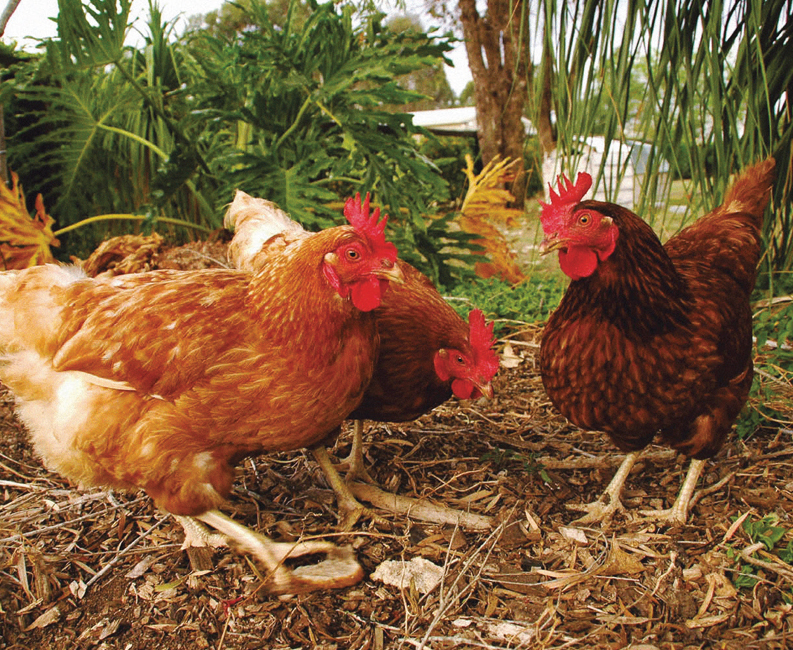
EGG SIZE
In Australia, egg sizes are graded on the basis of their weight as follows: (Source; Australian Egg Corporation Limited Labelling Guidelines)
BREED TYPE AND THE WEIGHT OF THE CHICKEN ARE OTHER FACTORS WHICH CAN AFFECT EGG SIZE. GENERALLY SPEAKING, THE OLDER THE CHICKEN, THE LARGER THE EGG.

DID YOU KNOW?
As the yolk travels through the oviduct, it is continually rotating, which twists structural fibres into rope-like strands that anchor the yolk in the thick egg white. This is why the yolk is always at the centre when you crack an egg open.
ALBUMEN TEXTURE
The albumen, or ‘egg white’, can vary in texture, from sitting high and close to the yolk (the ideal scenario) to being thin and runny (not so great).
Runny albumen can be caused by a number of factors. Fresh eggs will usually have a firmer albumen. Genetics also play a role, and generally speaking the older a hen is, the runnier the albumen will be in her eggs. Watery egg whites are also more likely when your flock doesn’t get enough key nutrients, like protein, in their diet.
MEAT SPOTS IN THE ALBUMEN
Another ‘no thanks’ for many people, ‘meat spots’ are thought to be pieces of albumen left behind during the formation of the previous egg, or sometimes fragments from the lining of the oviduct. However, just like blood spots, they are harmless and can be easily removed from the rest of the egg.
Meat spots can be pigmented or non-pigmented, and the pigment involved (Ooporphyrinse) is also a part of the colouration of brown-shelled eggs. Meat spots are therefore much less common in white-shelled eggs.
Unlike blood spots, meat spots can occur at any time throughout lay, no matter the age of the hen. However, birds that tend to lay eggs with meat spots are likely to continue to do so.
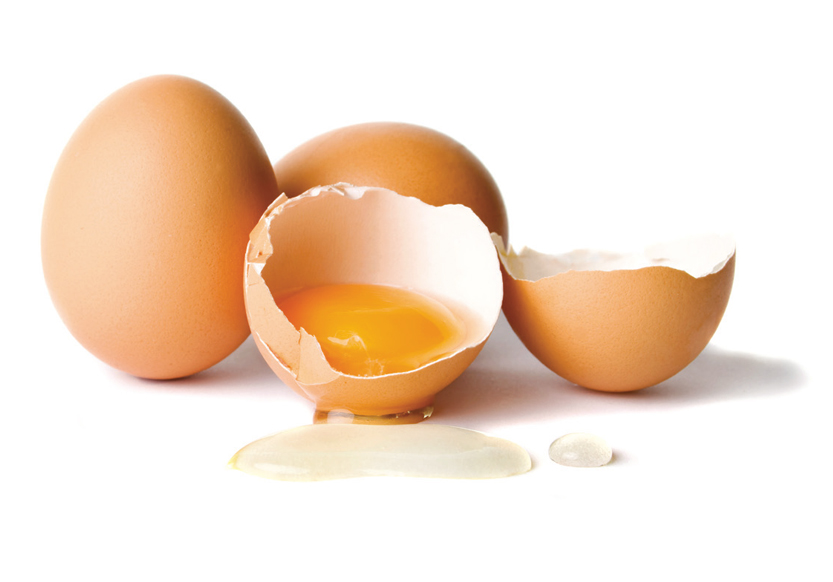
CHARACTERISTICS OF A FRESH EGG
As any backyarder will tell you, there’s no substitute for fresh eggs. Fresh eggs are more flavoursome, have a better nutritional profile and produce firmer cakes, custards and meringues.
The size of an egg’s air cell will always give away how fresh it is; the smaller the air cell, the fresher the egg. When it’s first laid, the egg doesn’t have an air cell at all. As it cools and loses moisture, a slight vacuum is created which draws air in through the porous shell. As the egg ages, this process continues and the air cell expands.
PRESERVING EGG FRESHNESS
Check your nesting boxes every day! The best way to keep your eggs fresh is to collect them as soon as they’ve been laid and put them straight in the fridge. As a rule of thumb, as much freshness is lost in 3 days at room temperature as in 3 weeks in the refrigerator! It is also important to check that your eggs are uncracked, clean and dry.
BACTERIA FROM DIRT AND STAINS CAN PENETRATE EVEN THROUGH AN UNBROKEN SHELL AND CAUSE THE EGG TO GO OFF, AND MOISTURE SPEEDS THE PROCESS.
To wash or not to wash?
It may surprise you to know that washing eggs is often not the best thing for them. Egg shells are porous, and washing has the potential to allow harmful bacterial inside. This can become a food poisoning risk, even in fresh eggs.
But wait. What about commercial eggs? Don’t they get washed?
Yes – it’s standard practice for commercial egg producers to wash eggs. However, these producers are obliged to follow strict procedures established by the Australian Food Standard Code, to ensure the safety of their product. As a backyard producer, you are unlikely to be able to reproduce these conditions, so we don’t recommend washing your eggs.
The good news is that if you’re maintaining your nesting boxes and following good hygiene practices in your hen house, your eggs shouldn’t need washing. If an egg does get a bit dirty, give it a brush with a clean, dry, abrasive cloth, using a gentle rubbing motion.
